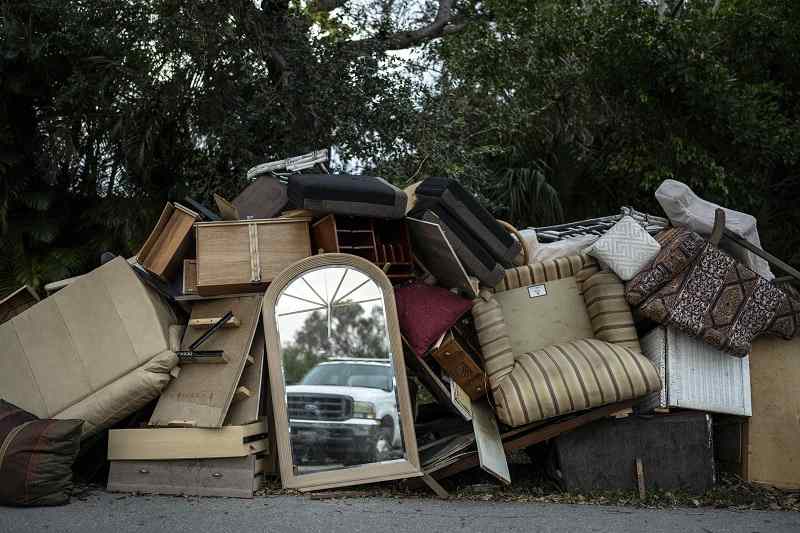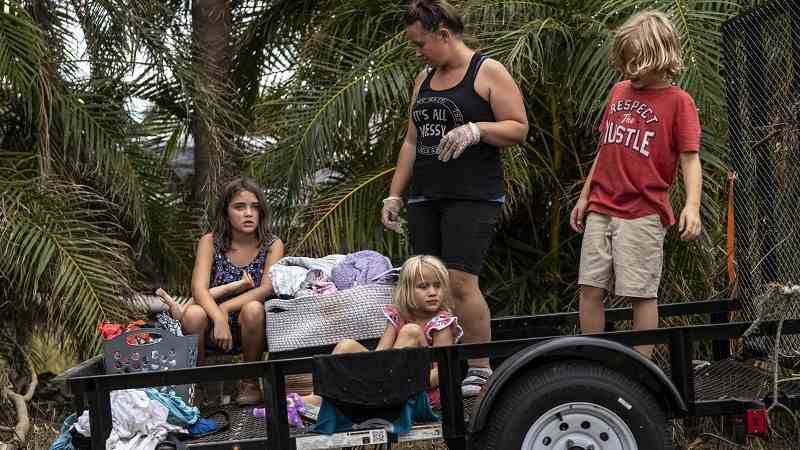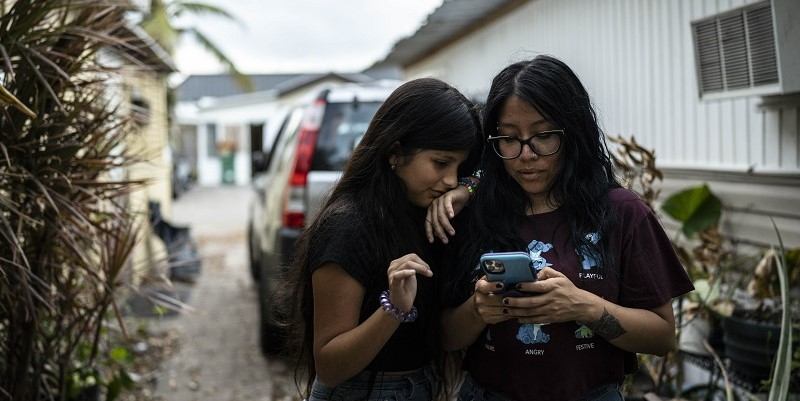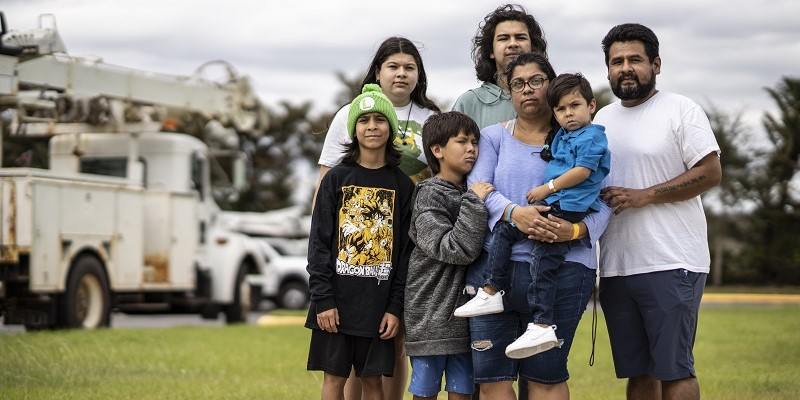
Household items that had been waterlogged by Hurricane Ian line the streets in Naples, Fla., on Oct. 8.
11:06 JST, October 20, 2022
ESTERO, Fla.
- Here are some of the things kids lost when Hurricane Ian came ashore:
- – A Mickey Mouse plush toy that had been named “Baby.” Miniature hangers that once hung doll clothes. Three pairs of Converse sneakers – one blue, one black and one white. Polaroids of friends making funny faces. Three “All About Me” books, which siblings had filled in to mark their fifth birthdays. A mango tree. A pet chameleon named Rex.
- – School days.
- – Karate lessons.
- – Home.
The magnitude of this storm has been measured in many ways – the dollar amount of the damage it wrought, the height of the storm surge, the death toll, the number of households that lost power. None of those numbers really capture what this storm has meant for young people, who are often afterthoughts in storm response.
Lee County’s 94 schools and programs, which educate more the 90,000 students, shuttered the day before the storm, hallways emptying of students and, in some places, filling with evacuees who slept on the tile floors to wait out the hurricane. Out of the classroom, young people were severed from cafeterias – where every child in the district eats breakfast and lunch free – and classrooms and counselors.
Students started to trickle back in to classrooms on Monday, and by the end of the week at least 60 schools will be set to be open – even as repairs continue to fix ceilings and floors and clear debris. Others will take time to rebuild, and in the interim, students will log on for virtual classes. Three elementary schools were so badly damaged that they are closed indefinitely. Their students will reassemble at schools with spare classrooms while their home campuses are being reconstructed.
“We can minimize the impact in terms of the amount of time out of school,” Lee County Superintendent Christopher Bernier said in early October, as he helped volunteers at district headquarters assemble packages of food and bottled water for an unending line of cars waiting outside. He seeks to open the buildings as soon as possible. But, he added, “we cannot minimize the impact of what Ian did to us. We have to be prepared on a deeper level to deal with trauma and the mental health piece.”
Natural disasters have been shown to have deleterious impacts on children and adolescents: Young children may regress in their development, older ones can develop symptoms of anxiety and depression and those who narrowly escaped floodwaters can develop post-traumatic stress disorder.
Katie A. McLaughlin, a Harvard psychology professor who has studied how natural disasters and the pandemic affect children’s mental health, said that certain groups of young people are particularly vulnerable, including children who were proximate to the disaster – who lost loved ones, or their homes, who had to linger in shelters, who missed a lot of school – and kids who were already grappling with trauma linked to poverty or community violence. They are, she said, more likely to develop mental health problems that persist for months or even years.
***
Eden Rogers, 5, lost a school of tadpoles. The creatures had taken up residence in a pool of water in a kayak in the backyard. Eden refused to let her parents dump them out, so they instead transferred them to a plastic bin. Eden, apropos of her name, loves animals and was excited to see them grow into frogs. Now the tadpoles were gone, and the backyard was littered with all kinds of stuff that didn’t even belong to her, or anyone else in her family: seashells, a cage of propane tanks, a dead fish, a drowned duck.
When her parents evacuated to a house in Tallahassee two weeks ago, Eden begged her mother, Meghan, to take the tadpoles with them. But there was no room in the car, which was already carrying two of Eden’s siblings, two cats and a dog.
So Eden worried about what happened when the sea washed over her home, rising to nearly five feet inside, soaking nearly all of the family’s belongings. The surge had also taken her school on Sanibel Island, where she and two older siblings attended classes. To make matters worse, in the midst of all the uncertainty, Eden had been separated from her parents, who sent the kids to stay with their grandmother in suburban Tampa as they dealt with their ruined home.
Now life for her family is filled with change. The three youngest siblings would start classes next week, but not in the school building on the decimated island, which will need to be rebuilt. Instead, they will head to nearby San Carlos Park Elementary, where teachers were setting up in vacant classrooms.
When Eden reunited with her parents days later, she buried her face into Meghan’s stomach and wrapped her tiny arms around her, staying there for several seconds until Meghan picked her up and cradled her.
The material stuff is replaceable, said Meghan, a social worker who chose Sanibel School thanks in part to its focus on outdoor learning and ecological justice. But some things, such as routines, are harder to reconstitute: the sunrise commute to Sanibel Island to drop her kids off at school, the swim lessons, the stability. The family just settled in to the home in March, after moving from Buffalo, and spending months in a three-bedroom apartment while they searched for housing.
“The loss of stuff – that’s not what we’re really worried about,” Meghan said.

Meghan Rogers, with her children, from left, Avery, Eden and Steven, stand among the debris in the family’s backyard in Fort Myers, Fla., on Oct. 8.
***
Fairy Olivo, an 11-year-old aspiring astronaut, lost three pairs of Converse sneakers and a solar system diorama she built in the fifth grade. She was lounging on the bed of her mother, Elizabeth, when the water started seeping in through the door of their trailer in Naples. She panicked as it kept rising.
“We’re going to die!” she yelled to her mother.
As they escaped, her mother yelled at her to grab some clothes. But it was too late. The waist-deep water made it impossible for her to get to her bedroom, and even if she had, her bureau – stuffed full of her favorite jeans, her favorite T-shirts – was already submerged.
The rest of the household – her 5-year-old sister Imi McBride, her grandmother and her mother’s husband, Allen Jamal McBride – had already gone, trudging the murky water to a gas station that a neighbor had said was on dry ground. Now it was her turn. Standing barefoot at the threshold, she was scared. She could swim, but her mother couldn’t. And what if there were crocodiles in the water? Her mother Elizabeth yelled to her: “C’mon! You can do it!”
Finally, Fairy stepped into the water, carrying a lavender backpack and one of her mother’s purses. She followed her mother – who had fiery pink hair – across the street. They waited out the storm beneath the canopy of the gas station – where other neighbors had gathered – as the wind whipped debris around them. Imi put on her mother’s jacket, spread her arms wide, let its oversize sleeves fill with wind and yelled “I’m flying!”
Later, the family returned to the flooded home, where the floors and the walls were still soaked. Her mother’s mattress had mostly been spared, so the entire family – Elizabeth, Imi, Fairy and Allen – curled up there and went to sleep. They slept that way for several nights until the family purchased a futon for Fairy.
“I was scared to be here,” Fairy said. “The room was dirty, and it smelled bad because of the hurricane.”
Nearly a week later, the smell of mildew was still thick in the air. Fairy returned to school a week and a day after her home was flooded. She had lost every pair of shoes she owned, save for a pair of black and red Nike Dunks that they had salvaged. On the first day back, the stylish sixth-grader slipped them on even though they didn’t match her outfit.
Fairy had never liked living in this place, where her room was dark and cramped. Her family had moved in to this trailer with Elizabeth’s mother when their rent went up, forcing them from their apartment. And now it had been stripped bare of all her possessions. Not just the clothes, but also the small library of books she had amassed. She was fond of the “Jacky Ha-Ha” book series, about a middle school prankster. And the solar system diorama, which she treasured because she dreamed of someday going to space.
Standing out in the streets – now lined with the ruined contents of flooded homes – Elizabeth said she knew how much Fairy disliked their home. A bartender, she was working hard to make enough money for the family to get their own place. The flood was a setback.
“She just has to be patient,” Elizabeth said. She turned to her daughter: “We’re gonna make it.”

Fairy Olivo, left, stands with her mother, Elizabeth Olivo, outside their home after it was flooded.
***
Jaikobie Garcia, 4, lost a small Mickey Mouse plush toy that he had named “Baby” and his collection of stuffed-animal sharks. He and his family – his mother Ana, father Jose and four older siblings – left their home the night before the storm arrived. Most of them thought they would stay the night, so they traveled with not much beyond the clothes on their backs and the shoes on their feet. Jaikobie was at least wearing his favorite pair: yellow Croc sandals with charms in the shapes of cars.
Now they were stuck at Hertz Arena,in normal times the home of the region’s minor league hockey team, the Everblades. Since the storm, though, it had housed hundreds of people desperate to escape the storm. Those who remained did so because the storm had wiped out their home. The Garcias, who had lived in the converted car port of a trailer owned by Jose’s parents, were among them. The water swept in with such force that it soaked and tossed their possessions everywhere. Their section of the trailer – where five kids and two adults slept – had been deemed uninhabitable.
Out of the entire family, no one had taken the displacement as hard as Jaikobie. He kept begging to return home.
“It’s been really stressful,” said Jalizza, at 17 the eldest sibling. One of the hardest things, she said, was having to watch Jaikobie try to make sense of what had happened. “My brother wants to be going home, but we don’t really have a house no more.”
It tortured Ana: “As a 4-year-old, how do you explain to them that there’s nowhere to go any more?”
The day after the storm, hoping it would help him understand, his parents took him back to the trailer so he could see why they couldn’t live there. Water had flooded their room and violently tossed around their possessions. A tree had fallen nearby. Many of their neighbors endured the same – or worse.
“It’s okay, I can clean it up and rebuild,” he told Ana, she recalled.
A week later, Jaikobie sat on the curb outside the arena despondent. He and Ana had passed a donation pile with a toy power drill that he wanted. Ana said they had to get lunch first, but by the time they got back, another child had taken it. He had already lost so much, and now, how was he going to rebuild the house without the power drill?

The Garcia family, starting clockwise from back row left: Jalizza, Jhoxey, Jose, Jaikobie, Ana, Jeydren and Juztyn.
***
Here are some of the things salvaged from the wreckage of Hurricane Ian: an Xbox that miraculously survived in a plastic box, a pair of dance shoes right before classes restarted, a 3D sonogram photo.
Even though children are considered the most vulnerable storm victims, McLaughlin emphasized that many come out unscathed. About a quarter of kids have symptoms of anxiety or depression that resolve on their own. Another quarter have “clinically significant” symptoms that require the help of a professional. About half “are resilient, even in the face of these major stressors.”
Barbara Ammirati of Save the Children, an organization that aids children in humanitarian crises, said there are many factors that can mitigate the impact of natural disaster, including ensuring access to counselors and therapists and giving children a place that feels safe and familiar. It’s why her group has advocated to reopen schools and day-care centers as soon as possible.
“You have all the protective factors on one side and then you have all of these risks and that the negative impacts on the other end,” Ammirati said. “And the more you can build up those protective factors on that side of the seesaw, the child really has the ability to cope and come back very strong.”
Still, the effects can last, and they are not always visible. Children who have already weathered traumatic situations – like poverty, community violence or the pandemic – are particularly vulnerable.
Standing outside the stadium with tears in her eyes, Jaikobie’s mom, Ana, described how loss from hurricanes in her family had become generational. As a teenager living in the same area, her parents’ home had flooded, destroying all her possessions. Her family came to the arena then, too. She’d lost everything to floods twice more when she was in her 20s, including once when Jalizza was 4. The possibility that her whole world could suddenly vanish always lingered in the back of her head. It made it hard for her to ever truly feel at home.
Now she was watching the same thing unfold for her youngest child.
"News Services" POPULAR ARTICLE
-

American Playwright Jeremy O. Harris Arrested in Japan on Alleged Drug Smuggling
-

Japan’s Nikkei Stock Average as JGB Yields, Yen Rise on Rate-Hike Bets
-

Japan’s Nikkei Stock Average Licks Wounds after Selloff Sparked by BOJ Hike Bets (UPDATE 1)
-

Japan’s Nikkei Stock Average Buoyed by Stable Yen; SoftBank’s Slide Caps Gains (UPDATE 1)
-

Japanese Bond Yields Zoom, Stocks Slide as Rate Hike Looms
JN ACCESS RANKING
-

Keidanren Chairman Yoshinobu Tsutsui Visits Kashiwazaki-Kariwa Nuclear Power Plant; Inspects New Emergency Safety System
-

Imports of Rare Earths from China Facing Delays, May Be Caused by Deterioration of Japan-China Relations
-

University of Tokyo Professor Discusses Japanese Economic Security in Interview Ahead of Forum
-

Japan Pulls out of Vietnam Nuclear Project, Complicating Hanoi’s Power Plans
-

Govt Aims to Expand NISA Program Lineup, Abolish Age Restriction



















